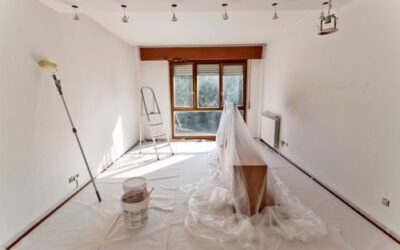At Bartolomé Bas Pintores, terrace waterproofing is one of our specialities, using solutions based on waterproofing paint to prevent problems of damp, leaks and deterioration. Over time, a terrace exposed to inclement weather can develop cracks and leaks that affect both the surface and the structure below. In this guide, we explain how to waterproof your terrace effectively, using professional waterproofing paint to ensure long-lasting results.
Why waterproof a terrace with paint?
Waterproofing a terrace with paint is a practical and effective solution. Unlike other methods, waterproofing paint provides a flexible protective layer that adapts to any surface and helps prevent leaks without modifying the structure of the floor. Moreover, because it is easy to apply and cheaper than other techniques, such as asphalt sheets, waterproofing with paint makes it possible to renew the protection of the terrace in a simple way and without the need for complicated building work.
Contact our professionals
Advantages of waterproofing with waterproofing paint:
- Ease of application: The paint can be applied quickly to various surfaces.
- Flexibility: It adapts to terraces with slopes or irregularities.
- Easy maintenance: It allows for occasional touch-ups in case of wear and tear.
- Improved aesthetics: Different finishes and colours are available to improve the visual appearance of the terrace.
Types of waterproofing paint
There are various waterproofing paint options on the market, and choosing the right one will depend on the condition of the surface and the specific needs of your terrace. Here are the most common types.
Acrylic waterproofing paint
Acrylic waterproofing paint is one of the most commonly used because of its durability and weather resistance. This type of paint creates a protective layer that blocks the passage of water and is ideal for terraces that are exposed to sudden changes in temperature. It also has reflective properties, making it perfect for hot climates, as it helps to reduce the surface temperature.
Advantages:
- UV and weather resistance.
- Easy to apply and fast drying.
- Can be applied on a wide range of surfaces, including tiles.
Polyurethane waterproofing paint
Another popular option is polyurethane waterproofing paint, which is noted for its elasticity and ability to seal cracks in terraces. Being more flexible than acrylic paint, it is ideal for surfaces that expand and contract with heat or cold. It is also highly resistant to abrasion, making it suitable for busy terraces or those exposed to constant use.
Advantages:
- Superior elasticity to adapt to material expansion.
- Resistant to wear and tear and frequent footfall.
- Protects against moisture and structural damage.
Process for waterproofing a terrace with paint
Waterproofing a terrace with waterproofing paint requires a step-by-step process to ensure that the surface is effectively and durably protected. Here’s how to do it.
Step 1: Cleaning and preparing the surface
Before applying the waterproofing paint, it is essential that the terrace is thoroughly cleaned. Remove any dirt, dust, or previous paint residues, as these can affect the adhesion of the new coat of paint. If you find cracks or fissures, repair them with a suitable filler to ensure a uniform base.
It is also advisable to lightly sand areas with imperfections so that the paint adheres properly and covers the surface well.
Step 2: Primer application
The next step is to apply a coat of primer or sealer to improve the adhesion of the waterproofing paint. The primer helps the paint to set properly and maximises protection against moisture. Be sure to use a primer that is compatible with the type of waterproofing paint you will be using, whether it is acrylic or polyurethane.
This step is crucial, as a good primer greatly improves the effectiveness of the waterproofing.
Step 3: Applying the waterproofing paint
Once the primer is completely dry, you can proceed with the application of the waterproofing paint. Use a roller or brush to spread the product evenly over the entire surface of the terrace, paying special attention to the joints and corners, where there is usually more risk of leaks.
Generally, it is recommended to apply at least two coats of paint to ensure complete protection. Allow the first coat to dry according to the manufacturer’s instructions before applying the second coat.
Step 4: Inspection and maintenance
Once the waterproofing paint has been applied, it is important to carry out a visual inspection to ensure that no areas have been left uncovered or under-applied. If you notice any problem areas, apply an additional coat of paint.
Maintenance of the waterproofing is also straightforward. It is advisable to check the terrace regularly, especially after periods of heavy rain, to ensure that there are no signs of wear and tear or small cracks. If they are found, one advantage of waterproofing paint is that you can touch up those areas without having to apply a new coat over the entire terrace.
Other publications that may interest you
Paint suitable for basements and poorly ventilated rooms
Basements, storerooms or garages have unique conditions: poor ventilation, high humidity and increased risk of mould or condensation. Using conventional paint in these spaces is a common mistake that leads to ephemeral finishes and health problems due to fungi or...
How often should a house be painted depending on its use?
The frequency with which you should paint a house is not always the same. It depends on several factors: the use given to each room, the quality of the paint used, exposure to light or humidity, and even the colour. In this guide we explain how often you should renew...
Tips for painting a room without staining doors and sockets
Painting a room may seem like a simple task, but without the right preparation it's easy to end up with splashes on doors, sockets, switches and even skirting boards. If you want a clean, professional finish, we've got the best tips to avoid stains and save you...




